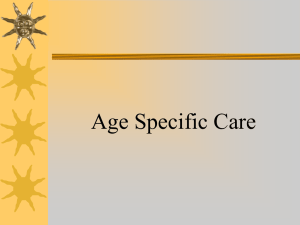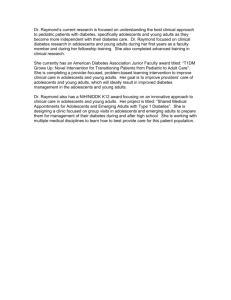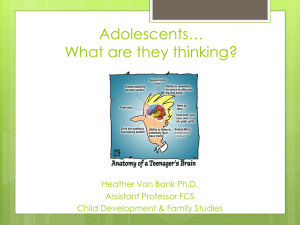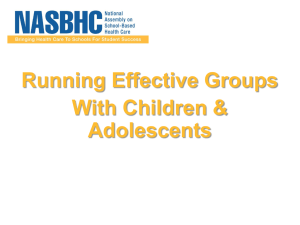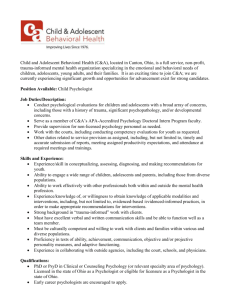Microsoft Word 2007
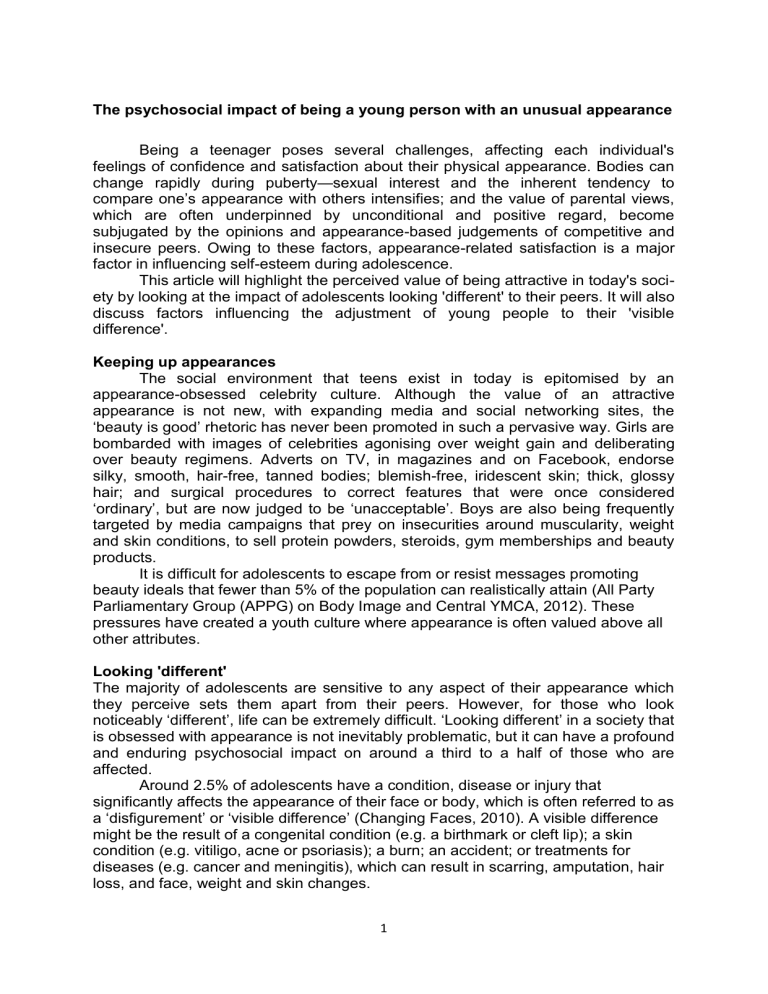
The psychosocial impact of being a young person with an unusual appearance
Being a teenager poses several challenges, affecting each individual's feelings of confidence and satisfaction about their physical appearance. Bodies can change rapidly during puberty —sexual interest and the inherent tendency to compare one’s appearance with others intensifies; and the value of parental views, which are often underpinned by unconditional and positive regard, become subjugated by the opinions and appearance-based judgements of competitive and insecure peers. Owing to these factors, appearance-related satisfaction is a major factor in influencing self-esteem during adolescence.
This article will highlight the perceived value of being attractive in today's society by looking at the impact of adolescents looking 'different' to their peers. It will also discuss factors influencing the adjustment of young people to their 'visible difference'.
Keeping up appearances
The social environment that teens exist in today is epitomised by an appearance-obsessed celebrity culture. Although the value of an attractive appearance is not new, with expanding media and social networking sites, the
‘beauty is good’ rhetoric has never been promoted in such a pervasive way. Girls are bombarded with images of celebrities agonising over weight gain and deliberating over beauty regimens. Adverts on TV, in magazines and on Facebook, endorse silky, smooth, hair-free, tanned bodies; blemish-free, iridescent skin; thick, glossy hair; and surgical procedures to correct features that were once considered
‘ordinary’, but are now judged to be ‘unacceptable’. Boys are also being frequently targeted by media campaigns that prey on insecurities around muscularity, weight and skin conditions, to sell protein powders, steroids, gym memberships and beauty products.
It is difficult for adolescents to escape from or resist messages promoting beauty ideals that fewer than 5% of the population can realistically attain (All Party
Parliamentary Group (APPG) on Body Image and Central YMCA, 2012). These pressures have created a youth culture where appearance is often valued above all other attributes.
Looking 'different'
The majority of adolescents are sensitive to any aspect of their appearance which they perceive sets them apart from their peers. However, for those who look notice ably ‘different’, life can be extremely difficult. ‘Looking different’ in a society that is obsessed with appearance is not inevitably problematic, but it can have a profound and enduring psychosocial impact on around a third to a half of those who are affected.
Around 2.5% of adolescents have a condition, disease or injury that significantly affects the appearance of their face or body, which is often referred to as a ‘disfigurement’ or ‘visible difference’ (Changing Faces, 2010). A visible difference might be the result of a congenital condition (e.g. a birthmark or cleft lip); a skin condition (e.g. vitiligo, acne or psoriasis); a burn; an accident; or treatments for diseases (e.g. cancer and meningitis), which can result in scarring, amputation, hair loss, and face, weight and skin changes.
1
Difficulty in social situations
Irrespective of the cause or nature of a visible difference, teenagers who struggle to adapt to their unusual appearance typically report difficulties with social situations and describe experiences of discrimination and stigmatisation. This is especially related to, but not limited to, those with a visible difference that cannot be camouflaged by clothing or make-up.
Many people also highlight negative reactions to their appearance by peers and strangers, such as staring, pointing and whispering; unsolicited questioning or comments; teasing or bullying at school; and being avoided or rejected by their peers and sometimes by members of their own family. Staring or questioning by others is not always intended to cause distress or offence; it can also reflect concern, curiosity and the need for explanation as to the cause of the visible difference. However, irrespective of the motives behind these responses, they can increase a young person’s sense that he or she is permanently on public display, which increases selfconsciousness. Similar difficulties can also arise as a result of 'institutional gaze'
—a term that describes the intense scrutiny and constant involvement of health professionals in the lives of individuals who may require repeated trips to hospital for multiple assessments and surgeries, for example, to manage traumatic injuries, skin disorders or craniofacial conditions.
Desire to fit in
Being labelled as ‘different’ and experiencing social discrimination can impact on psychological wellbeing. Young people who perceive that they do not match up to current beauty ideals report feeling unattractive and sexually unappealing, which can lead to depression, low self-esteem, anger or resentment about the reactions of others. Social anxiety, leading to the avoidance of normal social activities, is also commonly experienced.
Typically, adolescents want to ‘fit in’ with peers and experience social anxiety, at least in part, because they are fearful of being rejected or excluded because of their unusual appearance (Kent, 2000). High levels of self-consciousness and social anxiety can have a debilitating and widespread effect. Young people can become preoccupied with their appearance to the extent that the focus of their attention and their interpretation of events becomes distorted; this can result in hypervigilance to the reactions of others, assumptions that they are being judged negatively by others
(when often this is not the case), and a heightened sensitivity to any reactions (Kent and Keohane, 2001).
This preoccupation with appearance can result in individuals becoming distracted, anxious or lacking in confidence, and can also create an awkward tension that inhibits their social interactions and draws more attention to them. Adolescents learn that they can reduce anxiety by removing themselves from anxiety-provoking social situations, and this avoidant behaviour can become reinforced and lead to self-imposed social isolation.
Making friends
Making friends and integrating into new and extended peer groups requires a level of social confidence and can be challenging for adolescents with low self-worth (Hearst et al, 2008). Social avoidance or rejection can lead to isolation from peer groups and wider society. Adolescents with visible differences can have fewer friends and vocational aspirations, and have been found to academically underachieve compared with their peers (Lovegrove and Rumsey, 2005)
2
Romantic relationships
Appearance anxiety can also impact on the development of romantic relationships. Healthy romantic relationships can improve self-esteem, social competence and promote peer relationships. Social and appearance anxiety can inhibit the ability to initiate relationships and make it considerably difficult for the individual to allow or enjoy intimacy. Fear of rejection can lead young people to conceal their differences or avoid intimacy altogether (Griffiths et al, 2010).
Factors influencing adjustment of young people
Not all young people struggle with a visible difference; some consider it to have a minor or even positive impact on their lives (Rumsey, 2002). Variation in psychological make-up, social support and use of coping strategies can influence outcomes and there may be much to learn from those who display resilience and adjust successfully.
Objective and subjective assessment in research
Although research is limited among adolescents compared with the adult population, studies indicate that the severity, cause and location of a visible difference are poor pre dictors of distress (Feragen, 2012). Instead, an individual’s subjective assessment of how noticeable the difference is to others is a more useful predictor. Those with more noticeable differences may learn to adjust more positively because the responses of others tend to be predictable and individuals know what reactions to expect; in contrast, for those whose difference is not always noticeable, perhaps because their condition can flare up or subside (e.g. psoriasis), the unpredictable nature of others’ reactions can make it difficult (Moss, 2005).
Therefore, rather than relying on objective assessments or personal judgements, it is important to ask people how they judge and feel about their appearance.
Self-concepts
The content and organisation of an indi vidual’s self-concept—the mental image or perception that one has of oneself
—is also thought to influence adjustment.
Those who highly value the attribute of appearance and invest a lot of time and energy in their looks, rather than other aspects, are more likely to experience appearance distress. Adolescents with a well-rounded and diverse self-concept, who value themselves for other important attributes such as intelligence, determination and kindness, are likely to fare better (APPG on Body Image and Central YMCA,
2012).
Social acceptance and support
Social acceptance and support from family members, friends and health professionals is also important. The values, attitudes and behaviours of families are particularly influential; children tend to model their behaviour on their parents and receiving messages that highly value appearance attributes, or appearance-related teasing and criticism, can reinforce appearance ideals and dissatisfaction.
Adolescents are more likely to adjust to their visible difference in a supportive, lowstress environment, with parents who value attributes other than appearance, and where they feel comfortable discussing appearance without fear it will cause parental distress (Bellew, 2012).
How can health professionals help?
3
Adolescents need psychosocial support as an alternative solution or addition to medical or surgical solutions. Appearance is a highly sensitive and private subject, which adolescents are reluctant to raise with adults —particularly those who think their concerns will be minimised as trivial or secondary to physical well-being.
Therefore, health professionals can play a vital role in validating and destigmatising appearance worries, by encouraging adolescents to express their concerns and helping them to access specialist support.
Psychosocial support typically focuses on self-management skills such as social interactions skills training, to help young people develop the ability to overcome social stigma and improve social interactions; and cognitive behavioural therapy, which addresses negative appearance-related thoughts, challenges inaccurate assumptions individuals make about the behaviour of others, and uses graduated exposure to reduce levels of social anxiety. As access to specialist therapies can be limited, online interventions have been developed that can be readily accessed at home (e.g. www.ypfaceit.co.uk). These resources can help to overcome barriers preventing young people from having face-to-face therapy, such as having to wait long times and travel large distances to access expertise, and being absent from school to attend sessions.
Conclusion
This article has discussed the causes and impact of appearance distress among adolescents, particularly those with conditions, injuries or treatment side-effects that result in an altered or different appearance. It has also considered the factors that contribute to more positive outcomes which are currently underpinning the formulation of educational, psychological and social interventions targeting health professionals, families and individuals. These interventions aim to provide carers with the knowledge and skills to support the adolescent and to empower young people to manage the social and emotional challenges associated with looking
'different'.
The pervasiveness of appearance-related distress among all adolescents and the insidious stigma associated with facial disfigurement makes it clear that a change in social attitudes is also needed. Although there is a growing, albeit slow, political and social momentum to both tackle the issue of widespread appearance dissatisfaction and assert pressure to increase societal acceptance of appearance diversity in the media and advertising industries, ultimately everyone has a responsibility to consider their attitudes towards appearance.
Key Points
1. Adolescents are part of a youth culture that highly values appearance and are typically exposed to numerous pressures to meet often unrealistic beauty ideals.
2. A large number of adolescents are affected by numerous conditions, injuries or treatment side-eff ects that result in an unusual or ‘different’ appearance.
3. Looking different can have an enduring and profound psychosocial impact that is often not related to the severity or extent of a visible difference, but
4
rather individual differences in the value placed on appearance related to other attributes within the self-concept, social support from friends and family, and social skills.
4. Those affected require psychosocial support as an alternative or addition to medical/surgical solutions, and health professionals play a vital role in encouraging adolescents to identify and express their appearance-related worries and in helping them access specialist support.
References
All Party Parliamentary Group on Body Image (2012).
Reflections on Body Image:
All Party Parliamentary Group on Body Image. Available from: http://www.ymca.co.uk/bodyimage/report [Accessed 5th December 2012]
Bellew, R. (2012) The role of the family. In N. Rumsey & D. Harcourt (eds) The
Oxford Handbook of the Psychology of Appearance , pp 239-252 London: Oxford
University Press.
Changing Faces (2010) The Face Equality Campaign: The Evidence. The incidence and prevalence of disfigurement . Available from: http://admin.changingfaces.org.uk/downloads/FE%20Campaign,%20Epidemiology%
202%20pages.pdf [Accessed 5 th December 2012]
Hearst, D., Middelton, J. A. Owen T., & Zefferett, A. (2008) Teasing and Bullying in
Children with Clefts: A Framework for Formulation . Document prepared for the Cleft
Special Interest Group.
Feragen K. B. (2012) Congenital conditions. In N. Rumsey & D. Harcourt (eds) The
Oxford Handbook of the Psychology of Appearance , pp 353-371 London: Oxford
University Press
Griffiths, G., Williamson, H. Rumsey, N. (2012) The romantic experiences of adolescents with a visible difference: exploring concerns, protective factors and support needs. Journal of Health Psychology 17(7), 1053-1064
Kent, G. (2000). Understanding experiences of people with disfigurement: an integration of four models of social and psychological functioning. Psychology,
Health and Medicine, 5 , 117
–129.
Kent,G. & Keohane, S. (2001). Social anxiety and disfigurement: the moderating effects of fear of negative evaluation and past experience. British Journal of Clinical
Psychology , 40, 23-34.
Lovegrove, E. and Rumsey, N. (2005) Ignoring it doesn't make it stop: adolescents, appearance, and bullying. The Cleft Palate-Craniofacial Journal , 42 (1), 33-44.
5
Moss,T. (2005). The relationship between objective and subjective ratings of disfigurement severity and psychological adjustment.
Body Image , 2, 151-159.
Rumsey, N. (2002) Body image and congenital conditions with visible differences, In
T. F. Cash and T. Pruzinsky (eds.) Body image. A handbook of theory, research and clinical practice, pp 226-33. New York: the Guildford Press.
6

